What kind of downloads apps have, how to increase their number, what traffic parameters to look at after buying it, – says Vera Karpova, analyst at devtodev.
The publication is published as part of a series of materials about game metrics from App2Top.ru and devtodev. Articles are divided by seasons, each of which is dedicated to a specific topic. The second season, which we are starting with this publication, is called “Users”. In it, we talk about those business metrics that reflect the effectiveness of the application in terms of working with the audience.

Vera Karpova
Of course, it’s nice to look at the application installation schedule when it is actively growing upwards.
But does this mean that the revenue of the product will also begin to increase? Are all installations equally valuable and effective? Let’s try to answer these questions.
Obviously, the more users download the app, the better. Of course, first of all, it is beneficial from a financial point of view, since the more users in the product, the greater the number of paying and, accordingly, the income.
But in addition, the increase in the number of downloads leads to new downloads, thus forming a cycle. Let’s look at how this happens.
First of all, the level of downloads affects the position of the application in the search results and in the tops of mobile app stores. Accordingly, the more downloads, the higher the position in the top, the more users see the application and download it.
The second cycle is the cycle of virality, when users tell their friends, colleagues, acquaintances about the product. Therefore, the more users there are in the product, the more people they will tell about the application. Most often, virality is spoken of in a positive way, since in fact it is the dissemination of information about the product. But what exactly do users tell their friends about it? After all, it is important that this information is positive.
Therefore, it is worth taking care that the application makes a good impression on users, even those who do not pay, and those who leave, and the information is distributed to a greater extent positive. All this can be measured and analyzed, for example, using k-factor and NPS, but this is a topic for a separate article.
There is another attraction cycle – when, as a result of buying traffic in the application, there are more users (which triggers the cycles described above) and these users start paying, thus creating a budget for subsequent traffic purchases.
How to increase the number of installations?
To answer this question, first it should be said that installations can be of 2 types: organic – this is when users find and download the application directly from the store, and paid – when the developer pays for attracting new users.
Based on this, measures to improve certain installations will differ.
The cycles that we considered at the very beginning have a greater impact on organic installations, as they lead to the fact that users find and download the application better in the store.
In addition, organic downloads are affected by a set of measures called ASO (App Store Optimization), which is responsible for how attractive the app page looks in the store and how quickly the user can find it. The work on ASO consists in the selection of a “talking” icon and screenshots, a concise and informative description, correct keywords and names, as well as the availability of localizations for different countries. Properly selected, these elements will ensure a good “findability” of the application for relevant queries and an increase in the number of installations.
Optimizing the app page in the App Store, do not forget about the reviews that users of the product leave. They are also available for viewing in the app stores and may influence the user’s installation decision.
The big plus of organic installations is that they are free for the developer, except for the work on ASO.
Paid attraction works differently. Here, the developer already has to pay to get a new user. There are several types of campaigns for the purchase of traffic (payment for impressions, clicks, installations), they all have their pros and cons, but they are united by the fact that any channel of attraction needs to be carefully analyzed to avoid spending on inefficient sources.
Not every application download has a positive impact on revenue and it is extremely important to understand what kind of user installed the application, especially when it comes to paid traffic.
Therefore, when attracting users, it is worth analyzing a number of metrics, such as:
- conversion to registration or purchase;
- performing the most important actions in the product (browsing the store, completing the tutorial);
- Retention already from day 1, ARPU;
- number of sessions per user;
- the time before the first payment and others.
You can start tracking these metrics already in the first days after the user installs the application.
A little later, you can calculate such indicators as:
This is necessary in order to unambiguously determine the effectiveness of the attraction channel and assess the fact and timing of its payback.
It is important to note that it is worth comparing different channels of attraction using cohort analysis. This will allow you to compare companies launched at different times and having different durations.
By the way, it is also worth calculating the percentage of incoming traffic – which share is organic installations, and which is paid.
If the former make up a small percentage, and the audience increases mainly due to paid users, it is worth making sure that the paid traffic is of such high quality that it brings more money and pays off quickly. Otherwise, this situation is quite risky for the product, since it completely depends on paid attraction, without which it will not be able to grow independently and generate income.
In addition to the source of installations, when analyzing downloads, you can use other segmentation options and evaluate user metrics by such sections as country, device, gender, age, and so on. Usually users of different segments behave differently in the product, and their financial indicators are also different.
Despite the apparent simplicity of the downloads indicator, it can be investigated in quite detail and in depth, using segmentation, separating the sources of these installations, observing the subsequent behavior of attracted users in the product. Such a detailed analysis will allow you to monitor and improve the quality of traffic, which will directly affect the revenue of the application.
See also:


